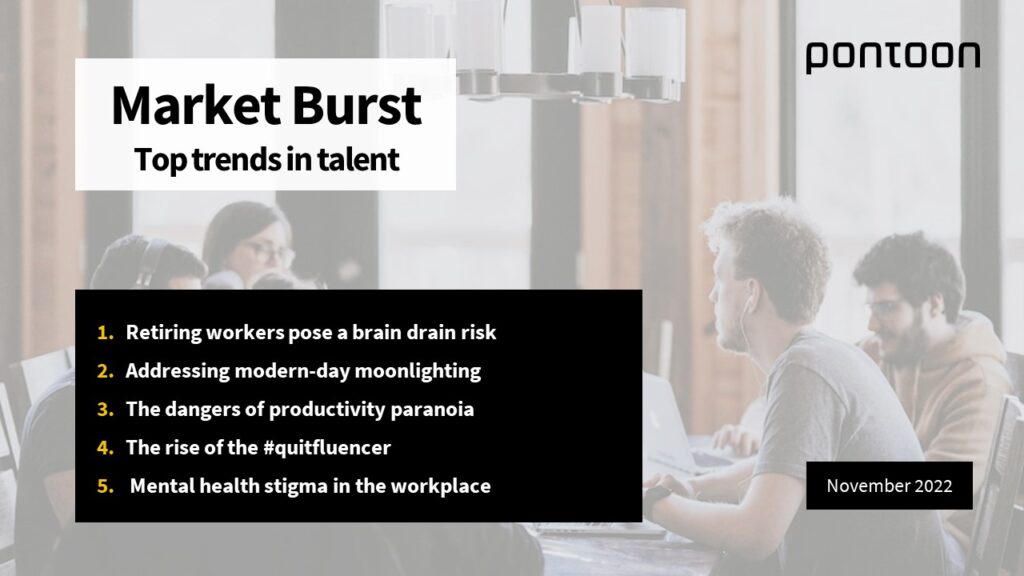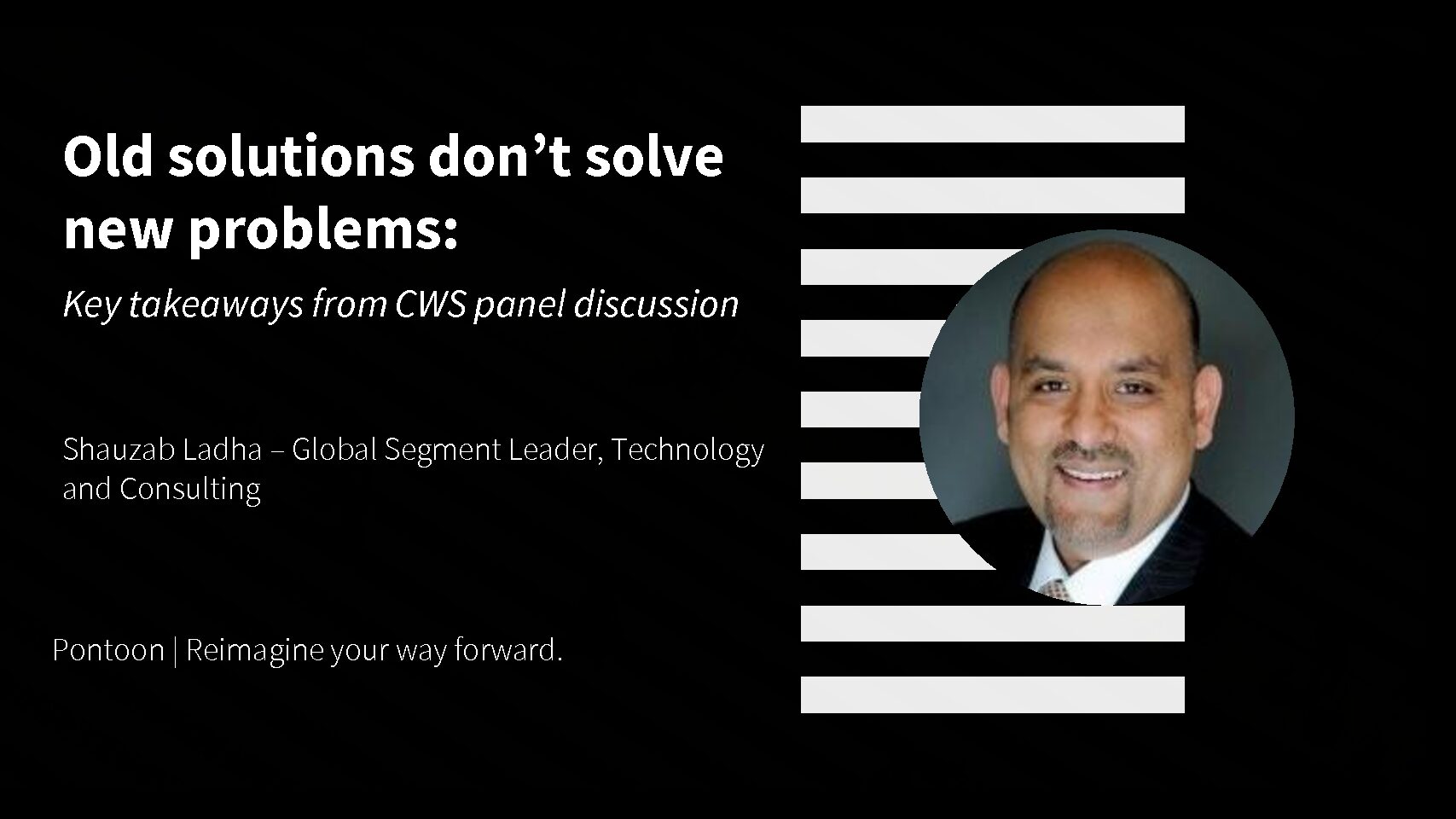Market Burst: November 2022
Read about top trends in the world of work.
In this month’s instalment of our Market Burst, we dive into brain drain risks caused by the retiring workforce, the dangers of productivity paranoia, the rise of #quitfluencer and more. Have a read below.
Retiring workers pose a brain drain risk
In an increasingly competitive job market, organisations are eager to hold on to top talent. Studies reveal that nearly 5 in 10 firms face challenges around brain drain and are impacted by the loss of critical skills as workers retire. Organisations should take advantage of this knowledge-rich generation who are still vital to company-wide success. Given the opportunity to work with more flexibility, 22% of this subset would even consider delaying retirement if they had better access to upskilling.
Unfortunately, there is a disconnect between employers and their retiring workers, as less than 4 in 10 companies are upskilling staff later in their careers, and just over a third offer late-stage skills development as part of the pre-retirement support. Firms must fill this gap if they want to retain talented senior employees for longer. Encouraging retirees to stay allows more time to transfer their invaluable knowledge and experience to other workers, further dampening the effects of brain drain.
The issue is becoming even more pressing as reports indicate that Gen Y and Millennials could be aiming for early retirement. While finishing full-time employment at 50 requires significant savings, employers should still consider the risk. Organisations must constantly re-evaluate the current workforce priorities and keep their people engaged with flexible work schedules, career development programmes, and a healthy work-life balance.
Addressing modern-day moonlighting
The rise of the gig economy and hybrid working has led to an increase in modern-day moonlighting. Nearly 7 in 10 US remote workers had a second job at the end of last year, with 37% holding two full-time roles. In 2022, this trend has been further accelerated by the spike in living costs and soaring inflation. For many workers, having two jobs is becoming a necessity rather than a choice.
There are a few concerns connected with this wide-spreading trend. While some wonder if working multiple jobs blurs the lines between the company and personal time, others ask if it’s ethical for employees to have two or more employers.
Firms should proceed with caution when addressing the issue. One way to ensure the company’s interests are kept intact is to have a well-written moonlighting policy with clearly laid out legal definitions and regulations around conflicts of interest. It’s equally important to communicate the specifics to all employees so that no one is left in the dark. Rather than enforcing policies that forbid secondary employment entirely, firms should regularly update and re-distribute employee handbooks and training that address workers’ responsibilities to protect the organisation – proprietary information, intellectual property, and electronic resources.
For many, taking another job is intrinsically connected with closing the gaps in family budgets. It is a duty for all employers to re-evaluate salaries and distribute market rate adjustments that reduce the need for secondary employment. Revisiting compensation practices might better address the underlying problem, thus eliminating the cause rather than just addressing the symptoms. This might be easier said than done, provided that many companies struggle to level their staff’s pay with inflation. As an alternative, firms can consider subsidising areas that strain home budgets like childcare and transportation stipends.
The dangers of productivity paranoia
Managers globally are unsure if their employees work hard enough in remote setups. Ironically, while the number of weekly meetings has increased globally in the last two years, 5 in 10 leaders report having less insight into what their workers do on a day-to-day basis. This leads to a newly developed phenomenon of productivity paranoia.
The perceived lack of visibility into how much work employees do has recently translated into an increase in the use of surveillance systems. In the past two and a half years, one in three medium-to-large US companies has adopted a system focused on tracking workers’ activities. While increased surveillance might ease managers’ productivity paranoia, it is bound to harm the company culture. When workers feel spied upon, they experience heightened stress, lower job satisfaction, increased absenteeism, and a desire to quit.
Rather than worrying about productivity metrics, leaders should ensure teams are aligned and supporting meaningful work. Firms with workforce retention targets, should provide clarity on the work that drives impact, no matter where their people are based. If workers are not clear on which tasks are crucial and should be handled as a priority, what feels like a productive day to the employee may seem like a waste of time to their manager. Studies show that workers who have clarity on what to focus on in their roles are seven times more likely to stay committed to their role. Maintaining clarity on job priorities is a win-win for both sides.
The rise of the #quitfluencer
Quiet quitting is a significant challenge for organisations struggling to retain their workforce. Once one top performer quits, a snowball effect can occur where other workers start to evaluate their employment. This is known as quitfluencing and many companies are increasing salaries and enhancing benefits to combat the effects.
In a recent Forbes article, Valerie Beaulieu-James, Chief Sales & Marketing Officer at the Adecco Group, encouraged companies to “tackle quitfluencing head on, making retention a top priority and ensure managers have career conversations with their team members as a crucial first step.”
Our recent Global Workforce of the Future 2022 report reveals that quiet quitting has triggered 70% of colleagues to consider looking for a new role themselves. In addition, 50% of workers who have seen others resign have acted and decided to leave in the next 12 months.
Employers must identify these critical influencers and understand their impact on employee morale. By identifying the people and implications, leaders can mitigate the impact to team culture and create more stability. Another key to retaining staff is promoting honest and open communication between managers and employees. Workers that feel seen and heard by their leaders are less likely to be persuaded by outside opinions.
Also, performing an organisational network analysis, as coined by Deloitte, can help managers visualise formal and informal working relationships, identifying any challenges and key influencers. The analytical study of personalities and group dynamics within an organisation maps out worker communication channels, helping employers build trust to safeguard against quiet quitting and negative influence.
Mental health stigma in the workplace
Ask any HR leader today, and they will tell you that mental health remains a top priority in 2023. In our new Global Workforce of the Future report, 24% of workers have seen their mental health worsen over the past year. Employers are combatting this decline by investing in new initiatives and tools focused on mental wellbeing, but the stigma of mental health in the workplace remains.
While discussing mental health has become much more normalised, only 17% of workers take a sick day when feeling mentally unwell and only 3 in 10 use all their paid time off each year. A recent poll showed that over half of UK workers mask their need for a mental health day and instead attribute it to a physical ailment. Many fear repercussions for communicating their mental health challenges which outweighs the foreseen benefit of asking for help. This approach must change, and employers need to take more responsibility for keeping workers mentally safe when performing work-related activities.
Organisations can integrate mental wellbeing into company core values, encouraging and celebrating mental health days and the importance of taking annual leave. This creates psychological safety and a culture where workers feel comfortable using available time off without fear of judgement. Manager coaching programmes can initiate conversations around mental health, helping staff prioritise their wellbeing at work and preventing burnout.
Companies should also consider upgrading and investing more in flexible virtual mental health and mindfulness courses and developing employee resource communities that are employer funded and focused on peer support and outreach. Caring for mental health in the workplace is no longer a bonus; it’s a necessity.
Related Post
Old solutions don't solve new problems – especially in talent acquisition. We have seen phenomenal changes and disruptions in the talent marketplace in the last two years. Employers have been ...





